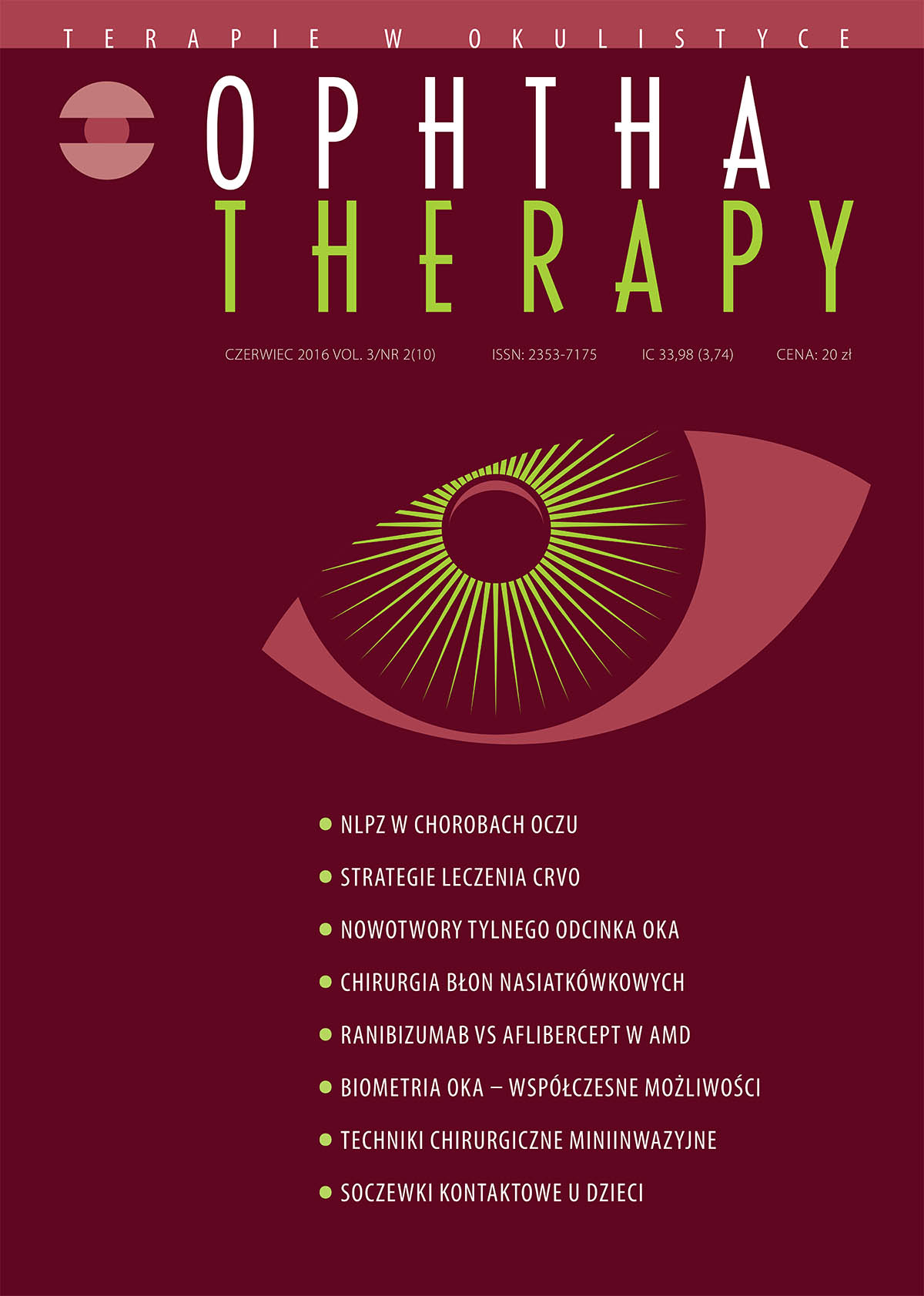Obecne techniki biometrii oka
##plugins.themes.bootstrap3.article.main##
Abstrakt
Operacja zaćmy jest obecnie najczęściej wykonywaną procedurą chirurgiczną w krajach rozwiniętych. Coraz częściej traktowana jest również jako zabieg refrakcyjny, a zastosowanie soczewek z grupy premium (asferycznych, torycznych, wieloogniskowych) pozwala pacjentowi na uniezależnienie się od korekcji okularowej i uzyskanie dobrej jakości widzenia do wszystkich odległości, nawet jeśli przed zabiegiem występowały starczowzroczność czy astygmatyzm. Wraz z poprawą standardów leczenia operacyjnego zwiększają się również oczekiwania pacjentów. Kluczowe jest uzyskanie jak najlepszej refrakcji pooperacyjnej. W tym celu przed operacją należy dokonać precyzyjnych pomiarów biometrycznych gałki ocznej i wybrać optymalną formułę obliczeniową do kalkulacji mocy wszczepianej soczewki. Celem pracy jest przedstawienie aktualnych metod przeprowadzania badań biometrycznych i najnowszych dostępnych w Polsce aparatów służących do biometrii oraz porównanie ich funkcji. Dokładne zrozumienie zalet i ograniczeń dostępnej na rynku aparatury oraz poznanie podstawowych zasad kalkulacji mocy wszczepianych soczewek pozwoli usprawnić procedury przeprowadzania badań i osiągać optymalne wartości refrakcji pooperacyjnej.
Pobrania
##plugins.themes.bootstrap3.article.details##

Utwór dostępny jest na licencji Creative Commons Uznanie autorstwa – Użycie niekomercyjne – Bez utworów zależnych 4.0 Międzynarodowe.
Copyright: © Medical Education sp. z o.o. License allowing third parties to copy and redistribute the material in any medium or format and to remix, transform, and build upon the material, provided the original work is properly cited and states its license.
Address reprint requests to: Medical Education, Marcin Kuźma (marcin.kuzma@mededu.pl)
Bibliografia
2. Zheng L, Merriam JC, Zaider M. Astigmatism and visual recovery after ‘large incision’ extracapsular cataract surgery and ‘small’ incisions for phakoemulsification. Trans Am Ophthalmol Soc. 1997; 95: 387-410.
3. Basic and Clinical Science Course, Section 3: Clinical Optics (2011–2012 ed). American Academy of Ophthalmology: 211-23.
4. Ossoinig KC. Standardized echography: basic principles, clinical applications, and results. Int Ophthalmol Clin. 1979; 19: 127-210.
5. Schelenz J, Kammann J. Comparison of contact and immersion technique for axial length measurement and implant power calculation. J Cataract Refract Surg. 1989; 15: 425-8.
6. Shammas HJF. A comparison of immersion and contact techniques for axial length measurements. J Am Intraocular Implant Soc. 1984; 10: 444-7.
7. Olsen T, Nielsen PJ. Immersion versus contact technique in the measurement of axial length by ultrasound. Acta Ophthalmol. 1989; 67: 101-2.
8. Lee AC, Qazi MA, Pepose JS. Biometry and intraocular lens power calculation. Curr Opin Ophthalmol. 2008; 19(1): 13-7.
9. Grzybowski A, Gaca-Wysocka M. Współczesna wiedza na temat soczewki. Przegl Okul. 2014; 4: 1-4.
10. Behndig A, Montan P, Lundström M et al. Gender differences in biometry prediction error and intra-ocular lens power calculation formula. Acta Ophthalmol. 2014; 92(8): 759-63.
11. Srivannaboon S, Chirapapaisan C, Chonpimai P et al. Clinical comparison of a new swept-source optical coherence tomography-based optical biometer and a time-domain optical coherence tomography-based optical biometer. J Cataract Refract Surg. 2015; 41(10): 2224-32.
12. Ventura BV, Al-Mohtaseb Z, Wang L et al. Repeatability and comparability of corneal power and corneal astigmatism obtained from a point-source color light-emitting diode topographer, a Placido-based corneal topographer, and a low coherence reflectometer. J Cataract Refract Surg. 2015; 41(10): 2242-50.
13. Huang J, Savini G, Wu F et al. Repeatability and reproducibility of ocular biometry using a new noncontact optical low-coherence interferometer. J Cataract Refract Surg. 2015; 41(10): 2233-41.
14. Chen YA, Hirnschall N, Findl O. Evaluation of 2 new optical biometry devices and comparison with the current gold standard biometer. J Cataract Refract Surg. 2011; 37(3): 513-7.
15. Aktas S, Aktas H, Tetikoglu M et al. Refractive Results Using a New Optical Biometry Device: Comparison With Ultrasound Biometry Data. Medicine (Baltimore). 2015; 94(48): e2169.
16. Kaswin G, Rousseau A, Mgarrech M et al. Biometry and intraocular lens power calculation results with a new optical biometry device: comparison with the gold standard. J Cataract Refract Surg. 2014; 40(4): 593-600.
17. Vogel A, Dick HB, Krummenauer F. Reproducibility of optical biometry using partial coherence interferometry: intraobserver and interobserver reliability. J Cataract Refract Surg. 2001; 27(12): 1961-8.
18. Hennessy MP, Chan GD. Contact versus immersion biometry of axial length before cataract surgery. J Cataract Refract Surg. 2003; 29: 2195-8.
19. Dmitriew A, Załęcki K, Kocięcki J. Implementacja biometrii optycznej w okulistyce – fakty i mity. Ultrasonografia. 2006; 26: 29-32.

